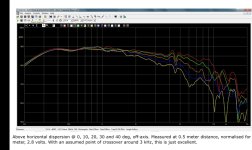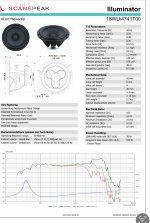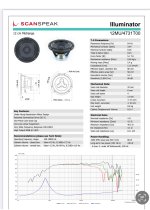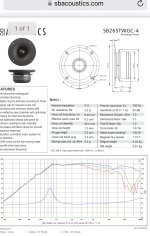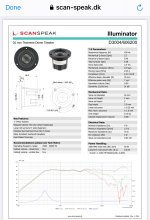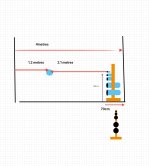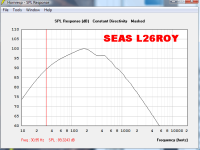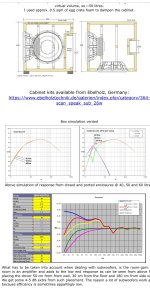I think your plan to add a new tweeter atop the Winslow is a logical step. But l am scratching my head on your implementation.
I recommend testing a tweeter on the Winslow but bear in mind my prior illustration of the ATC mid domes off axis performance relative to a flat front plate tweeter and a wave guide mounted tweeter.
You need to be really mindful of what any changes mean in a particular situation.
Otherwise you end up with links and dips in your precious off axis response lines which will earn you loathing feedback from your esteemed objectivist friends. They will listen with their eyes before their ears while perspiration drips down your brow.
To avoid this agonising predicament we must once again look at the facts.
But first a primer.
In what ever you decide to do a comparison will only be meaningful if in fact the chosen tweeter tracks the off axis lines of the ATC dome. Or alternatively the ATC dome tracks the MD60 Satori dome or a tweeter.
Confused? Read on…
This means looking at the off axis tracking through the crossover region and relative to the pass band of the mid dome and the tweeter.
In more detail the term CD or constant directivity isn’t a standard set in stone. It means even off axis lines across the frequency spectrum starting at the transition from the woofer to a horn or a dome tweeter from 700-1000 hertz through to 7,000 hertz.
This is assessed after normalising the on axis response to flat.
The idea is to have flat level lines in the 0, 10, 20, 30 range left and right and up and down. This is normally the listening window. Beyond that smooth lines are preferred. Above 7000 hertz a smooth level set of lines is not necessarily a desirable criteria.
The subjective result could be brightness or a recession in certain aspects of the presentation. This has the effect of impacting on the overall tonal balance when the direct and off axis sound sums at the listening position. The other impact is that sound stage can also become disproportionate in some frequency regions.
So you need to approach constant directivity with a degree of precision.
With a multi way system this is easier said than done. Hence horn loaded wave guides and wave guides on tweeters are becoming popular for those who hold CD - constant direction in high esteem.
In the table below l have set out the matrix of drivers discussed as a measurement of off axis level relative to on axis at 3kertz.
30 degree off axis tracking
2.5K. 3K. 3.5K. 4K. 4.5K
18WU4741. -3. -4. -4. -7. -9
MD 60. -1.5. -2. -3. -3.5. -4.5
ATC mid. -2.5. -3.5 -4.0 -4.5 -5
Tweeter
3004/606. 0.0. +1.5 +1. -1.5. -1
Wave guide
SB26STW -1. -1.5 -2. -2.5. -3
Scan mid
12MU4731. -1. -2. -2. -3. -4
Looking at the above results my pick of any pairing is as follows. Ranked in degree of difficulty to implement easiest to hard work.
trend Simple solution as both drivers
have designed in diffraction and CD
3. 18WU4741+MD60+SB26STW
150 hertz - 800 hertz in 17L for B2
sealed , cross to MD60 800 & 3,800 hz
Cross mid dual woofers with
independent low pass crossover filters.
Complex and difficult to implement.
2. 12MU4731+ SB26STW crossover
3.5Khertz, 18WU4741 crossover 350
hertz, delete 70 hertz HP filter
Comment. Both track closely relatively
A good combo with a discrete narrow
band mid bass woofers 70-350 hertz
Less complex than No 3 as the single
Mid driver operates 350-3.5 khertz
Dual 8 inch sealed mid mass woofers
require only one low pass cross over @
350 hertz. 12 db HP Bessel Transfer
function will does not require an
active high pass filter
an active HP filter @ 70 hertz for
music reproduction.
I recommend testing a tweeter on the Winslow but bear in mind my prior illustration of the ATC mid domes off axis performance relative to a flat front plate tweeter and a wave guide mounted tweeter.
You need to be really mindful of what any changes mean in a particular situation.
Otherwise you end up with links and dips in your precious off axis response lines which will earn you loathing feedback from your esteemed objectivist friends. They will listen with their eyes before their ears while perspiration drips down your brow.
To avoid this agonising predicament we must once again look at the facts.
But first a primer.
In what ever you decide to do a comparison will only be meaningful if in fact the chosen tweeter tracks the off axis lines of the ATC dome. Or alternatively the ATC dome tracks the MD60 Satori dome or a tweeter.
Confused? Read on…
This means looking at the off axis tracking through the crossover region and relative to the pass band of the mid dome and the tweeter.
In more detail the term CD or constant directivity isn’t a standard set in stone. It means even off axis lines across the frequency spectrum starting at the transition from the woofer to a horn or a dome tweeter from 700-1000 hertz through to 7,000 hertz.
This is assessed after normalising the on axis response to flat.
The idea is to have flat level lines in the 0, 10, 20, 30 range left and right and up and down. This is normally the listening window. Beyond that smooth lines are preferred. Above 7000 hertz a smooth level set of lines is not necessarily a desirable criteria.
The subjective result could be brightness or a recession in certain aspects of the presentation. This has the effect of impacting on the overall tonal balance when the direct and off axis sound sums at the listening position. The other impact is that sound stage can also become disproportionate in some frequency regions.
So you need to approach constant directivity with a degree of precision.
With a multi way system this is easier said than done. Hence horn loaded wave guides and wave guides on tweeters are becoming popular for those who hold CD - constant direction in high esteem.
In the table below l have set out the matrix of drivers discussed as a measurement of off axis level relative to on axis at 3kertz.
30 degree off axis tracking
2.5K. 3K. 3.5K. 4K. 4.5K
18WU4741. -3. -4. -4. -7. -9
MD 60. -1.5. -2. -3. -3.5. -4.5
ATC mid. -2.5. -3.5 -4.0 -4.5 -5
Tweeter
3004/606. 0.0. +1.5 +1. -1.5. -1
Wave guide
SB26STW -1. -1.5 -2. -2.5. -3
Scan mid
12MU4731. -1. -2. -2. -3. -4
Looking at the above results my pick of any pairing is as follows. Ranked in degree of difficulty to implement easiest to hard work.
- ATC mid + SB26STW crossover 3Khertz
trend Simple solution as both drivers
have designed in diffraction and CD
3. 18WU4741+MD60+SB26STW
150 hertz - 800 hertz in 17L for B2
sealed , cross to MD60 800 & 3,800 hz
Cross mid dual woofers with
independent low pass crossover filters.
Complex and difficult to implement.
2. 12MU4731+ SB26STW crossover
3.5Khertz, 18WU4741 crossover 350
hertz, delete 70 hertz HP filter
Comment. Both track closely relatively
A good combo with a discrete narrow
band mid bass woofers 70-350 hertz
Less complex than No 3 as the single
Mid driver operates 350-3.5 khertz
Dual 8 inch sealed mid mass woofers
require only one low pass cross over @
350 hertz. 12 db HP Bessel Transfer
function will does not require an
active high pass filter
an active HP filter @ 70 hertz for
music reproduction.
Attachments
Last edited:
A question(s)for the owner
How many feet do you sit from the Winslow system?
How far out is the front baffle from the front wall?
What is the distance from your listening position to the rear wall?
How far is the left and right loudspeaker from each side wall?
I re read your previous post on your experiences with room correction and the affirmative feedback from your friends.
Can you describe how you went above getting the Winslow system to perform to the point it is now?
What have you discovered along the way?
Looking at the attached sketch how have you located your listening position?
How many feet do you sit from the Winslow system?
How far out is the front baffle from the front wall?
What is the distance from your listening position to the rear wall?
How far is the left and right loudspeaker from each side wall?
I re read your previous post on your experiences with room correction and the affirmative feedback from your friends.
Can you describe how you went above getting the Winslow system to perform to the point it is now?
What have you discovered along the way?
Looking at the attached sketch how have you located your listening position?
Attachments
Last edited:
This could help once Jheaustin answered the question in last Macka's post.
http://tripp.com.au/sbir.htm
http://tripp.com.au/sbir.htm
Apparently. I actually know the guy. Quite smart.This could help once Jheaustin answered the question in last Macka's post.
http://tripp.com.au/sbir.htm
I had a look at the prices of these ScanSpeak drivers. They are pricing themselves out of the market.
My suggestion is get the most out of what you have. Ring every last drop of diy goodness out of it…
My suggestion is get the most out of what you have. Ring every last drop of diy goodness out of it…
Some bedtime reading
https://hificompass.com/en/reviews/purifi-ptt65m08-nfa-01a-65-true-midrange
https://hificompass.com/en/reviews/satori-tw29txn-b
The difference between Be and textreme
https://hificompass.com/en/reviews/purifi-ptt65m08-nfa-01a-65-true-midrange
https://hificompass.com/en/reviews/satori-tw29txn-b
The difference between Be and textreme
Last edited:
Given the overall cost of all new drivers jheaustin might consider an upgrade of the Winslow system with a new wave guide tweeter and a new diy music sub. This would add subjective value straight away.
Then re develop the system with the 2500.1 in a trapezoid shaped mid bass sealed enclosure.
The advantage is the side fronts would then match the retained ATC centre by retaining the ATC mid domes.
Just a thought.
Then re develop the system with the 2500.1 in a trapezoid shaped mid bass sealed enclosure.
The advantage is the side fronts would then match the retained ATC centre by retaining the ATC mid domes.
Just a thought.
I had a look at a sealed mid bass sim using the 2500.1 Volt woofer. In a critically tuned enclosure the VB is 20 L, a Bessel tuning is 13L. The F3 is 87 - 90 Hertz. It has 30% more VD than an 8 inch woofer. The notable feature of this driver is the high BL of 18.7 and a 75mm voice coil and 250 watts AES power rating. Made for the business.
All the Scan mid bass drivers are around 43mm. Like the ATC dome it would be interesting to at least try it in the proposed new design without spending a penny.
All the Scan mid bass drivers are around 43mm. Like the ATC dome it would be interesting to at least try it in the proposed new design without spending a penny.
I am very sorry that I have been too busy to post anything here. Thank you for all the suggestions and information.
I just briefly tried some enclosure volume calculator with a few candidate 8" drivers, to find that I can't get the small depth I prefer. What I got was 37 ~ 129 liter for f3 of 50 ~ 76Hz, PER DRIVER. Unless someone could suggest a breakthrough, I think I abandon the preference of relatively shallow enclosure, and go with something like Audio Physik or Vienna Acoustics, for the bass module, ensure sufficient volume for 2 drivers.
I used this calculator: https://www.diyaudioandvideo.com/Calculator/SpeakerBoxEnclosure/
for a Satori 7.5" papyrus, 2 Satori 8" paper and 1 Scanspeak classic 8" paper. The best seems to be the most expensive Scanspeak at a reluctant price range....
Sealed Box
Vas = 134 lts
fs = 20 Hz
Qts = 0.31
Qtc = 0.5
I guess there are different types of drivers better suited for sealed boxes... I will also look back at hybrid sealed+vented option. Are passive radiators any good to reduce to volume while maintaining f3?
I just briefly tried some enclosure volume calculator with a few candidate 8" drivers, to find that I can't get the small depth I prefer. What I got was 37 ~ 129 liter for f3 of 50 ~ 76Hz, PER DRIVER. Unless someone could suggest a breakthrough, I think I abandon the preference of relatively shallow enclosure, and go with something like Audio Physik or Vienna Acoustics, for the bass module, ensure sufficient volume for 2 drivers.
I used this calculator: https://www.diyaudioandvideo.com/Calculator/SpeakerBoxEnclosure/
for a Satori 7.5" papyrus, 2 Satori 8" paper and 1 Scanspeak classic 8" paper. The best seems to be the most expensive Scanspeak at a reluctant price range....
Sealed Box
Vas = 134 lts
fs = 20 Hz
Qts = 0.31
Qtc = 0.5

| Dimensions Vb = 2.95 ft3 = 83.67 lts = L x W x H f3 = 50.12 Hz fb = 32.26 Hz |
| Vb: Speaker Box Internal Volume f3: 3dB Cutoff Frequency fb: Enclosure Resonant Frequency |
I guess there are different types of drivers better suited for sealed boxes... I will also look back at hybrid sealed+vented option. Are passive radiators any good to reduce to volume while maintaining f3?
Yes, if you want a sealed box Qtc of 0.5, the box volume is always large. Are you sure you want a natural system Qtc of 0.5? With an active DSP system, it is often a better compromise to design a Qtc of 0.7 to 1.0, and then use DSP EQ to extend the bass. You can mimic exactly a Qtc of 0.5 if you wish, but with a much smaller cabinet size. A smaller cabinet has less surface area, and less opportunity for structural resonance.
In my room, I found a system Qtc of about 0.6 is the most natural sounding... This is after DSP Eq. My natural system Qtc is about 0.9 .
j.
In my room, I found a system Qtc of about 0.6 is the most natural sounding... This is after DSP Eq. My natural system Qtc is about 0.9 .
j.
Thank you hifijim.
I wish I could just quote a reply right below it. I can definitely boost the bass below the natural f3. Expecting the SVS 13" sub or future 12~15" side-firing passive subwoofer below it, what f3 do you think I should aim at with 2 8" woofer? 40~50Hz?
I wish I could just quote a reply right below it. I can definitely boost the bass below the natural f3. Expecting the SVS 13" sub or future 12~15" side-firing passive subwoofer below it, what f3 do you think I should aim at with 2 8" woofer? 40~50Hz?
After 574 posts, I sort of lost track of what your current configuration is... 2 x 8 woofers in a narrow cabinet, handing off to a large sub at about 50 Hz... yes?
As an example of what can be done....
Here is a pair of SB Satori MW19P-8 woofers in a 36 liter box (18 liter per driver). The dashed line is the natural response which has a Qtc of 0.85 and F3/F6 of 52/42 Hz. The solid line is with a shelf filter. Now the F3/F6 is 39/32 Hz, and the Qtc is about 0.8. The shelf filter is +4 dB, 47 Hz, 2nd order, Q=1.0

Here is a pair of SB Satori MW19P-8 woofers in a 36 liter box (18 liter per driver). The dashed line is the natural response which has a Qtc of 0.85 and F3/F6 of 52/42 Hz. The solid line is with a shelf filter. Now the F3/F6 is 39/32 Hz, and the Qtc is about 0.8. The shelf filter is +4 dB, 47 Hz, 2nd order, Q=1.0
Hi Jheaustin,
I was wondering if l had frightened you off.
These are my thoughts after a quite review of what l think your trying to achieve
1. A music sub such as the high quality Troels design l posted. This will in fact easily operate up to 150 hertz giving you some margin. The 30 cm woofer requires a 40x40x40 cm box - with passive radiators
2. Given the specifications of the music sub you can operate mid bass sealed enclosure with just a single woofer over 150-500 range
This would be an optimal mid bass situation in a sealed enclosure. You could go up to 800 hertz if that’s what ya want to do.
If your using stereo music subs thus is quite workable with a 150 hertz crossover point. A single woofer would be okay down to 100 hertz.
In my experience an 8 inch mid bass is best from 120-150 hertz . The small cone area just isn’t suitable for dynamic chest thumping bass at 50 hertz. The sub will over power two 8 inch sealed woofers.
I was wondering if l had frightened you off.
These are my thoughts after a quite review of what l think your trying to achieve
1. A music sub such as the high quality Troels design l posted. This will in fact easily operate up to 150 hertz giving you some margin. The 30 cm woofer requires a 40x40x40 cm box - with passive radiators
2. Given the specifications of the music sub you can operate mid bass sealed enclosure with just a single woofer over 150-500 range
This would be an optimal mid bass situation in a sealed enclosure. You could go up to 800 hertz if that’s what ya want to do.
If your using stereo music subs thus is quite workable with a 150 hertz crossover point. A single woofer would be okay down to 100 hertz.
In my experience an 8 inch mid bass is best from 120-150 hertz . The small cone area just isn’t suitable for dynamic chest thumping bass at 50 hertz. The sub will over power two 8 inch sealed woofers.
Attachments
Wrong? not likely.. There’s no reason active should sound better, there was nothing wrong with competent existing designs to begin with.at the end of the day I can honestly say it sounds just as good as my main, passively crossed speakers. Maybe I did something wrong,
- Home
- Loudspeakers
- Multi-Way
- 4-way instead of 3-way?
